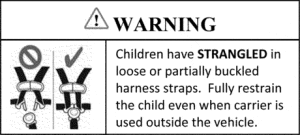CPSC Issues Final Rule for Hand-Held Infant Carriers
The Consumer Product Safety Commission (CPSC) has issued a Final Rule for Hand-Held Infant Carriers on Friday, December 6, 2013. The rule will become effective on June 6, 2014.
On December 10, 2012, the CPSC issued a notice of proposed rulemaking (NPR) for hand-held infant carriers. 77 FR 73354. The NPR proposed to incorporate by reference the then current voluntary standard, ASTM F2050-12, Standard Consumer Safety Specification for Hand-Held Infant Carriers, with certain modifications to strengthen the ASTM standard.
One proposed modification provided for a change in the warning label to better address suffocation and restraint-related hazards. The other proposed modification addressed the testing procedures for the carry handle auto-locking requirement and specified using an aluminum cylinder as the surrogate for the occupant of the carrier rather than a CAMI Mark II 6-month infant dummy (CAMI dummy).
Since the CPSC published the NPR, ASTM has revised ASTM F2050 twice. On July 1, 2013, ASTM approved an updated version of the voluntary standard, ASTM F2050-13, which includes the warning label modification proposed in the NPR.
On September 1, 2013, ASTM approved another revision of the voluntary standard, ASTM F2050-13a, which includes a carry handle auto-locking performance requirement that is different than the requirement proposed in the NPR.
The draft final rule incorporates by reference the most recent version of the ASTM standard, ASTM F2050-13a, with one modification—a clarification of the definition of “hand-held infant carrier,” to include a specific reference to both “rigid-sided” and “semi-rigid-sided” products.
Changes to Requirements of ASTM F2050-13a
The final rule modifies the definition of “hand-held infant carrier” to clarify that the definition includes products with semi rigid sides, as well as products that are rigid-sided. ASTM revised the hand-held infant carrier standard in 2012, to include a separate definition for “hand-held bassinets/cradles.”
A Moses basket meets the definition of a “hand-held bassinet” because a Moses basket is a freestanding product with a rest/support surface that is no more than 10° from horizontal, that sits directly on the floor, without legs or a stand, and has handles or hand-holds intended to allow carrying an occupant whose torso is completely supported by the product. However, because hand-held infant carriers (of which hand-held bassinets/cradles are a subset) are defined in part as “a rigid-sided product” and many Moses baskets have flexible sides, some manufacturers and importers may have interpreted the standard as excluding semi-rigid-sided products such as Moses baskets.
Because Moses baskets meet the definition of “hand-held bassinet/cradle,” and Moses baskets are not subject to any other durable children’s product standard (specifically ASTM F2194-13, Standard Consumer Safety Specification for Bassinets and Cradles), the CPSC has determined that Moses baskets are within the scope of the rule. The modification of the definition of “hand-held infant carrier” to include semi rigid-sided products clarifies that Moses baskets are covered by the rule.
Warning Label: The NPR proposed requiring a strangulation warning label to be affixed to the outer surface of the cushion or padding of a hand-held carrier seat in or adjacent to the area where the child’s head would rest. Under the proposal, the warning label for hand-held carrier seats that are intended to be used as restraints in motor vehicles would include a pictogram, while the warning label for hand-held carrier seats not intended to be used as restraints in motor vehicles would not include the pictogram because these seats do not have the chest clips depicted in the pictogram.
Handle Auto-Lock Test: The NPR proposed a modification of the test method for preventing the carrier from rotating and spilling an unrestrained infant when a caregiver picks up the carrier and the handle is not locked in the carry position. The test method in ASTM F2050-12 required the tester to use a standard CAMI dummy as an infant surrogate. The NPR proposed a change that would require the tester to use an aluminum cylinder designed as a surrogate for a 6-month-old infant, in lieu of the CAMI dummy, because testing had revealed that the CAMI dummy could be wedged into the seat padding or otherwise manipulated, so that the CAMI dummy did not fall out during the lift test when the CAMI dummy otherwise should fall. Furthermore, the Commission was concerned that the ability to pass or fail the test based on friction or placement of the CAMI would affect the consistency and repeatability of the test results.

